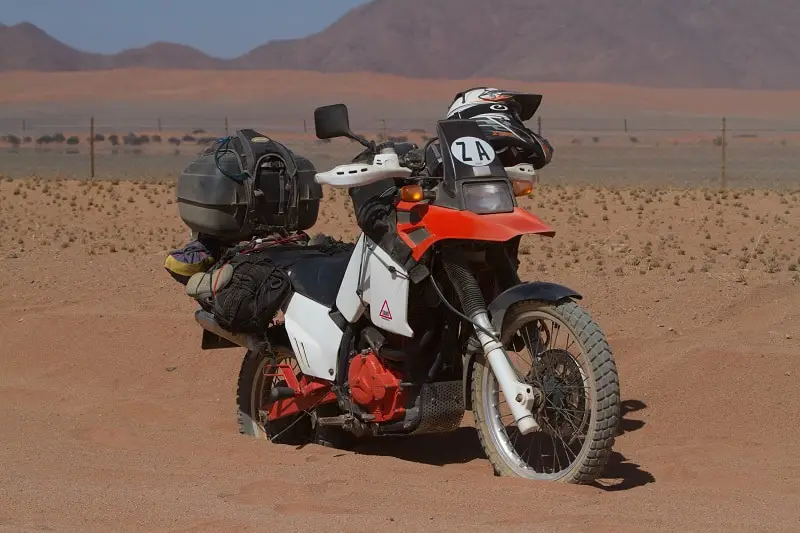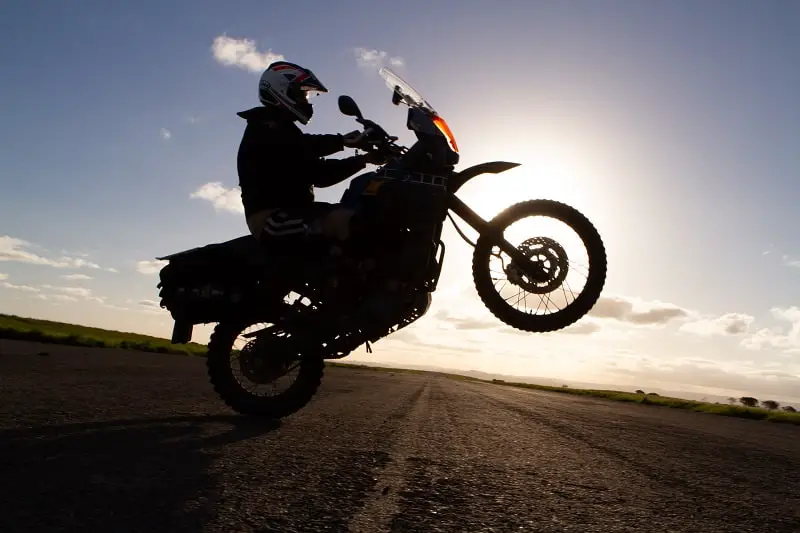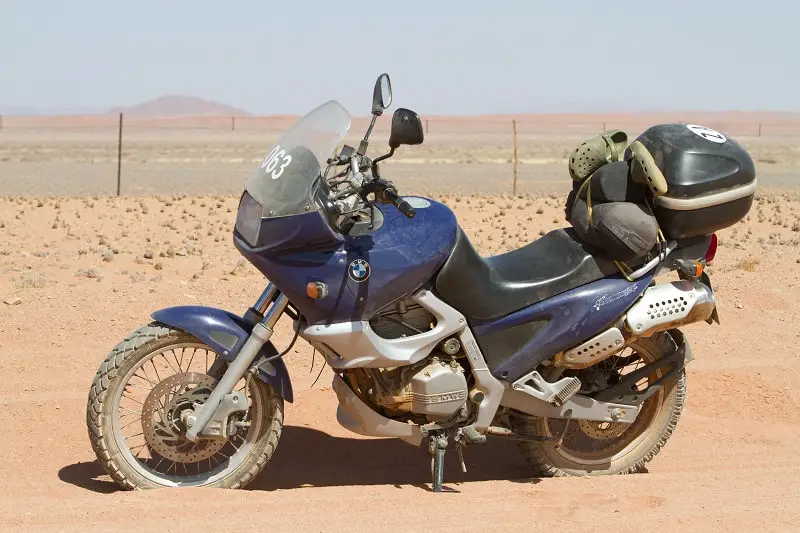A second-hand dual sport bike will take you all the places you can go on a new adventure bike. In fact, I’ll bet it will take you even further. You don’t need to spend $15 000 to $20 000 on a modern twin-cylinder adventure bike to tour across the continent on highways and desert tracks with your camping gear. A good old second-hand 650 cc dual sport will do the same for a fraction of the cost.
I’ve done some research on the 11 most popular second-hand dual sport bikes and have compared the specifications of each in this post. For a video on the dual sport motorcycles I’ve owned or toured with over the last decade, check out the video below:
The specifications is one thing, but nothing beats taking a bike for a test ride before making your final decision.
Here goes with the specs.
Longest Running Dual Sport Bike Models
The Suzuki DR 650 is the longest running production dual sport motorcycle. Launched in 1990, the DR 650 hasn’t changed much in three decades. The Honda XR 650 L is not far behind and it’s still being sold in the same form since 1993. If Kawasaki didn’t upgrade the KLR 650 in 2008 it would have been in production the longest.
Kawasaki launched the KLR 650 in 1987, closely followed by Suzuki’s DR 650 (in 1990) and Honda’s XR 650 L (in 1993). Unfortunately, the KLR got a severe upgrade (or downgrade, depending on who you ask!) in 2008. I owned two of the 1st generation KLR’s and it was unbreakable.
The benefits of decades long production runs are the plethora of aftermarket goodies available for these bikes. Know-how on the internet is also not in short supply from thousands of owners who’ve tried (and succeeded in many cases) to improve the stock bikes. Just visit www.klr650.net so see for yourself.

I’ve not ridden the DR 650 SE but am the current owner of a 2014 Honda XR 650 L, and the simplicity of the 1990’s design gives me great peace of mind.
Most Powerful Second-Hand Dual Sport Bike
The average power output of a 650 cc dual sport bike is 45 horsepower. The BMW F 650 GS Dakar and Suzuki DR 750 Big are the most powerful single-cylinder dual sport bikes with 50 horsepower. Most of the 650 cc dual sport bikes have similar power output figures on paper, but the way the power is delivered differs quite a lot.
Power is a function of torque (the next section) and engine speed (rpm). A bike with more torque, or a higher revving engine, will deliver more horsepower. While all the bikes listed here (apart from the ’75 granddad XT 500) deliver between 40 and 50 horsepower, there is not much difference in how the bikes perform on the road.

We did a drag race between a 2004 BMW F 650 GS Dakar, a 2011 Yamaha XT 660 Z Ténéré, and my old Kawasaki KLR 650 on an abandoned airstrip on an adventure bike trip and each time a different bike won. It depended more on the weight of the rider and how seamless we could launch our bikes and change gears.

One would think that the more modern BMW GS and the Ténéré with its electronic fuel injection would be more powerful than the older carbed motorcycles, but no. I could easily stay with the newer bikes on my KLR with its outdated 1987 technology.
Second-Hand Dual Sport Bike Torque
The ten torquiest 650 cc dual sport bikes deliver between 34 and 44 lb-ft of torque. The BMW F 650 GS Dakar has 44.2 lb-ft of torque, the highest of the budget dual sport bikes, followed by the Yamaha XT 660 Z Ténéré’s 42.8 lb-ft. The way each bike delivers the torque is very different.
I’ve ridden quite a few of the bikes on this list and the way they deliver very similar torque figures differs quite a lot between them. The torque of the BMW’s and the KLR’s feel more linear, pulling strongly all the way to the redline. The XT 500 and XT 660 Z packs a huge punch right from idle and want to lift the front wheel every time you crack open the throttle.

My XR 650 L putters along like a tractor and unleashes a (small) mountain of torque low in the rev range before it drops off well before the redline (which doesn’t exists – there’s no tachometer).

I’ve not ridden the KTM 640 Adventure or the Suzuki DR 650 SE, so I can’t comment on how they behave.
How Much do 650 cc Dual Sport Bikes Weight?
The average 650 cc dual sport bike has a wet weight of around 405 lbs with the Yamaha XT 660 Z Ténéré being the heaviest at 454 lbs. The Honda XR 650 L is the lightest 650 cc dual sport bike at only 348 lbs. Some bikes feel lighter due to having a low center of gravity, like the BMW F 650 GS Dakar with its gas tank under the seat.
The big advantage that a single-cylinder dual sport has over a modern twin-cylinder adventure bike is that it is lighter. This not only makes the bike easier to control in off-road situation, but puts less strain on the suspension, frame and wheels when riding over rough terrain.
Yes, many experienced riders can do amazing things on 600 lbs BMW R 1200 GS’s, but it is when you drop your bike for the tenth time in the deep sand of the Western Desert in Egypt that you will be glad you are picking up a 348 lbs Honda XR 650 L instead.

The XR 650 L and DR 650 SE have their smaller fuel tanks to thank (in part) for their position at the bottom of the list, but even a full 5.8 Acerbis aftermarket tank won’t make an XR heavier than a KLR.
How Tall is a 650 cc Dual Sport Bike?
The average single-cylinder dual sport bike has a seat height of around 34.7 inches. With a seat height of 37.2 inches, the KTM 640 Adventure is the tallest dual sport bike, while the BMW F 650 Funduro has the lowest seat height of only 31.9 inches.
One of the big criticisms of dual sport motorcycles are that they don’t accommodate shorter riders. The only 650 cc dual sport bike my wife (at 5 foot 2 inches) could comfortably ride was the BMW F 650 Funduro. On my old KLR 650 both her feet dangled in the air and she needs a ladder to mount my current Honda XR 650 L. At 6 foot dead, even I have to stand on my tip-toes to keep the XR upright.

The main reasons for the tall seat height of dual sport bikes are the long travel suspension, large diameter wheels and comfortable ergonomics. These characteristics make for great off-road manners, but can be challenging for inexperienced riders or if you have to put a foot down.

On many bikes you can adjust the seat height to some extent by setting the rear spring to its lowest setting. But for many riders, the only option is to fit lowering links to the suspension system, or to get a smaller displacement motorcycle or a BMW 650.
Ground Clearance of the Most Popular 650 cc Dual Sport Bikes
The average single-cylinder dual sport bike has around 9.6 inches of ground clearance below the engine. At 13 inches, the Honda XR 650 L has the most ground clearance thanks to long travel suspension, while the BMW 650’s are the lowest at 7.1 inches.
Ground clearance is important in rocky terrain where you risk hanging up your bike on a boulder or banging a hole in the engine. With very tall suspension, the Honda XR 650 L is high enough off the ground that I can literally crawl underneath it. I know, because I’ve done it just to see whether I’ll fit.

The lower the bike, like the BMW’s and the new KLR, the bigger the need for an aftermarket bash plate like this one (available on Amazon) to prevent damage to the underside of the bike. Generally, though, 650 cc dual sport bikes fare much better here than the more modern (and expensive) adventure bikes.
Suspension Travel of 650 cc Dual Sport Bikes
The average dual sport bike suspension travel is 9 inches (230 mm) in the front and 8.8 inches (223 mm) in the rear. The KTM 640 Adventure has the longest travel suspension front and rear with 320 mm and 300 mm respectively. The BMW F 650 Funduro has the least suspension travel, with only 165 mm in the front and 170 mm in the rear.
More suspension travel allows the motorcycle to absorb bumps and jumps off-road much more effectively. A bike with lots of suspension travel, will have taller suspension and therefore more ground clearance and a taller seat height. The KTM and Honda are again the clear winners if you are looking for a more off-road biased machine. The DR’s and the old shape KLR is somewhere in the middle, with the BMW’s and the new shape KLR at the other (road-biased) end of the spectrum.
I find it strange that the Ténéré is so far down the graph.

We’ve covered most of the important aspects that set these 650 cc single dual sport bikes apart. There is one thing, however, that can be a deal-breaker if you intend to travel long distances with your dual sport. And that is the range you can get from one tank.
Gas Tank Capacities of Second Hand Dual Sport Bikes
The average dual sport motorcycle has a 5 gallon gas tank which should be enough for a range of between 200 and 300 miles between fill ups. With a capacity of only 2.8 gallons, the Honda XR 650 L has the smallest gas tank while the KTM 640 Adventure has the biggest tank at 7.4 gallons.
Funnily enough, the two bikes I left out above (due to being discontinued in the 80’s) are the ones with the largest and smallest gas tanks. The XT 500 was one of the very first dual sport bikes and actually won the inaugural Paris-Dakar rally. The stock bike, however, had a small 2.3 gallon steel tank. Another Dakar legend, often referred to as the Desert Express, is the Suzuki DR 750 Big (or ‘Dr Big’) with its massive, two-piece 7.7 gallon gas tank.
I’ve owned both bikes and even though they are old, a well kept example can still be a reliable touring companion. A friend of mine toured through Namibia with us for two weeks with all his luggage and his wife on the back of his DR 750 Big without any issues.

I love how my Honda XR 650 L is so much lighter, better sprung and higher off the ground than my previous two KLR 650’s, but what I really miss about the old Kawa is that big 6 gallon gas tank. With less than half (2.8 gallon) capacity, I’ll be looking at a replacement tank for my Honda XR 650 L in the near future. Like this one from Acerbis (actually available on Amazon).
Which Second-Hand Dual Sport Bike is Best?
Choosing the best dual sport bike is like choosing the best thing to have for lunch. While all the dual sport bikes in the 650 cc single-cylinder class produce similar power outputs and top speeds, there are some big differences in riding characteristics. Each one of the bikes in this post has the ability to ride comfortably on the highway at 75 mph or play in the dirt and on the trails.
I’ve owned and toured with more than half of these bikes and can comfortably say that you can cross Africa with all your camping gear on the back, no problem! If you have to choose a bike, it will come down to personal preference. Obviously, if you are a short rider, you’d be stuck with the BMW’s (not a bad thing necessarily), but apart from that they all do the same things but in different ways.
Arguably the best way to choose a dual sport is to place them on a scale from ‘serious off-road‘ to ‘highway comfort‘ and decide where you are going to spend most of your time. In order to objectively rank the bikes I sorted the list according to the three things that make the biggest difference off-road:
- Weight (lighter is better)
- Ground clearance (higher off the ground is better)
- Suspension travel (longer travel is better)
I then averaged the scores of the three categories above and came up with the following list that ranks the most popular single-cylinder dual sport bikes from ‘Off-Road Beast‘ to ‘Street Comfort‘
1. KTM 640 Adventure R
2. Honda XR 650 L
3. Suzuki DR 650 SE
4. DR 750 BIG
5. KLR 650 (87-07)
6. Yamaha XT 600 E
7. BMW F 650 GS Dakar
8. Yamaha XT 660 Z Ténéré
9. Yamaha XT 500
10. Kawasaki KLR 650 (2008-2018)
11. BMW F 650 Funduro
Just remember, while the Honda XR 650 L is without a doubt better off-road than the BMW F 650 Funduro, an experienced dirt bike rider on the Beemer will leave a newbie on an XR in his (or her) dust!
Which New Adventure Bike is Best?
Many riders use the terms dual sport bike and adventure bike interchangeably, while others argue there is a difference. I’ve written a post that tries to explain the main characteristics that are generally used to make the distinction between dual sport and adventure bikes. You can read it here or watch the video below:
I’ve also compiled a post, with videos and specification tables, on the top 14 most popular adventure bikes which you can check out here.
